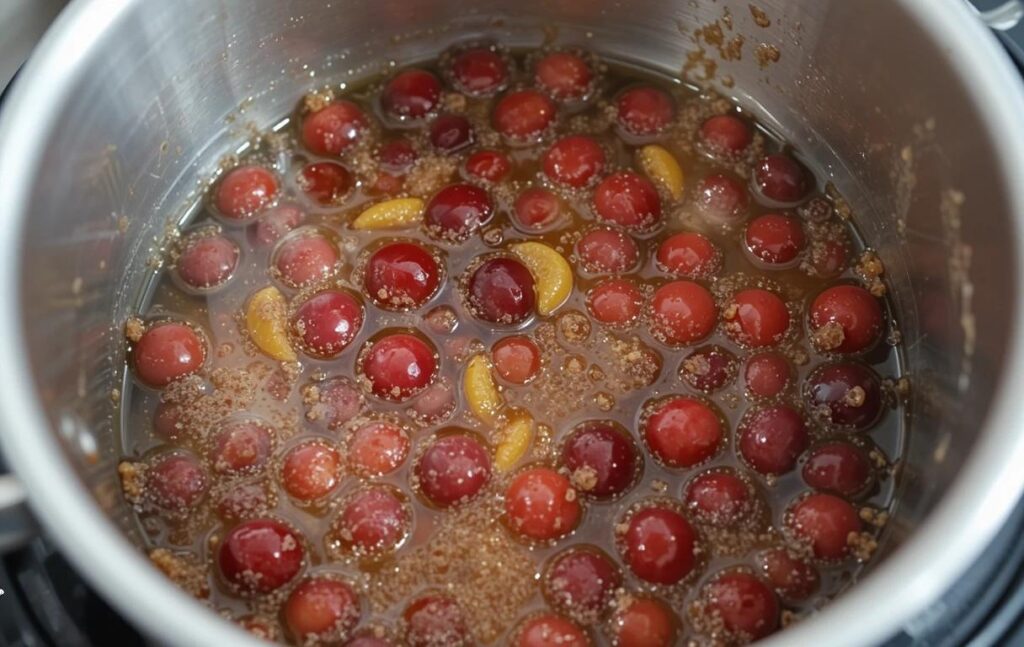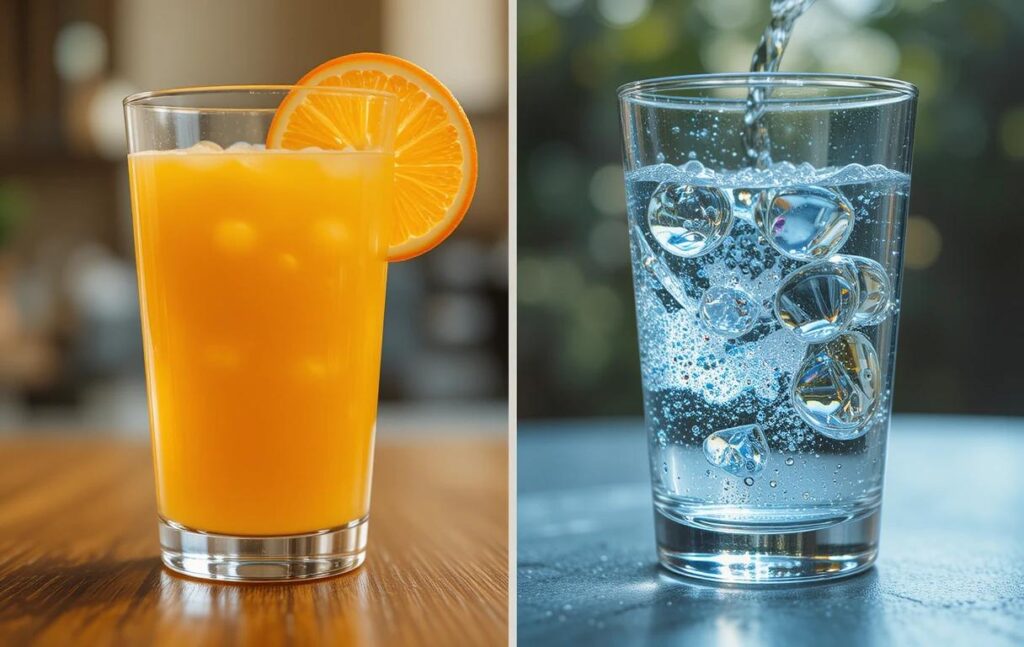Can I use orange juice instead of water for cranberry sauce?
Cranberry sauce is a classic addition to holiday meals, often accompanying turkey and stuffing. While the traditional recipe calls for water to cook the cranberries, many people wonder if orange juice instead of water for cranberry sauce could work. The idea might seem unconventional, but substituting orange juice can bring a vibrant twist to this beloved dish, enhancing its flavor and nutritional value.
This article explores whether orange juice is a viable substitute for water, how it changes the dish, and how you can prepare your own version of cranberry sauce with this citrusy touch.
What is Cranberry Sauce?
Cranberry sauce is a staple in many holiday traditions, especially in North America, where it’s often served alongside Thanksgiving and Christmas meals. It’s a simple dish typically made by simmering cranberries with water and sugar until the berries burst and create a tangy, sweet, and slightly thickened sauce.
The versatility of cranberry sauce makes it suitable for various uses, from being a turkey complement to acting as a spread for sandwiches or a topping for desserts. Despite its simplicity, the balance of flavors is key to its appeal, and the choice of ingredients can significantly influence the final dish.
Quick Overview of Traditional Ingredients
- Cranberries: Fresh or frozen berries are the base of the sauce.
- Water: Provides the liquid necessary for cooking the cranberries.
- Sugar: Balances the tartness of the cranberries.
- Optional Additions: Spices like cinnamon or nutmeg, citrus zest, or even liquors like brandy.
Why Consider Orange Juice?
Substituting water with orange juice instead of water for cranberry sauce might sound unusual, but it offers several compelling reasons to try it:
Flavor Enhancement
Orange juice naturally complements the tartness of cranberries, adding a layer of sweetness and depth that water simply cannot provide. The citrusy notes make the sauce more dynamic and appealing to the palate.
Nutritional Benefits
Using orange juice introduces vitamins, particularly Vitamin C, and antioxidants into the dish, enhancing its health benefits. Compared to plain water, orange juice contributes a nutritional boost while adding minimal additional calories.
Creative Twist
For those looking to break away from tradition and experiment in the kitchen, orange juice offers a simple yet effective way to elevate a classic recipe. It’s an easy substitution that can make your cranberry sauce stand out.
How Orange Juice Affects Cranberry Sauce
Using orange juice instead of water for cranberry sauce transforms the dish in several ways. From enhancing its flavor to altering its texture and appearance, this substitution provides a refreshing twist. Let’s break down the effects:
1. Flavor Profile
Orange juice significantly elevates the flavor profile of cranberry sauce. The natural sweetness of the juice reduces the need for added sugar, creating a balanced blend of tangy and sweet. The citrus undertones also complement the tartness of the cranberries, offering a well-rounded taste that feels brighter and more complex than the traditional water-based version.
- Key Flavor Notes: Sweet, tangy, zesty, with a slightly floral citrus aroma.
- Perfect Pairings: This enhanced flavor pairs beautifully with savory dishes like roasted turkey or ham and adds a gourmet touch to desserts.
2. Texture Changes
Using orange juice may result in a slightly thicker sauce due to the natural sugars and pulp present in the juice. The liquid’s viscosity helps the cranberries break down more cohesively, resulting in a sauce that’s smooth yet textured with whole or partially broken berries.
- Thicker Consistency: Ideal for spreading or using as a filling for pastries.
- Glossy Finish: The sugar content in orange juice creates a shiny glaze on the sauce, enhancing its presentation.
3. Visual Appeal
The vibrant hue of orange juice contributes to the color of the cranberry sauce, making it even more visually striking. The final dish often boasts a deeper, jewel-like red with subtle orange undertones, adding to its appeal on the table.
- Holiday-Ready Look: This colorful update makes the sauce pop against neutral-colored dishes like turkey or mashed potatoes.
- Photo-Worthy Presentation: The rich color combination of red and orange enhances its aesthetic appeal for food photography or gatherings.
Pro Tip: Adding a pinch of orange zest further intensifies the citrus notes and adds a touch of brightness to the flavor and appearance.
Step-by-Step Recipe: Cranberry Sauce with Orange Juice

If you’re ready to create a flavorful twist on the classic cranberry sauce, this recipe using orange juice instead of water for cranberry sauce is perfect. It’s easy to prepare and adds a gourmet touch to any meal.
1. Ingredients Needed
Here’s what you’ll need to make cranberry sauce with orange juice:
- Fresh or frozen cranberries (12 ounces / ~340 grams)
- Orange juice (1 cup / ~240 ml) – freshly squeezed for the best flavor, or bottled without added sugar
- Sugar (¾ to 1 cup / ~150-200 grams) – adjust to taste
- Orange zest (1 teaspoon) – optional, for extra citrus notes
- Cinnamon stick (optional) – for a warm, spiced flavor
Optional Add-Ins:
- A splash of vanilla extract for a rich aroma.
- A pinch of nutmeg or cloves for holiday warmth.
- Chopped pecans or walnuts for texture.
2. Instructions
- Prepare the Ingredients
- Rinse the cranberries under cold water and pick out any soft or damaged ones.
- If using fresh oranges, zest one orange before juicing it to capture the zest.
- Combine Ingredients
- In a medium saucepan, combine the cranberries, orange juice, and sugar. Add the orange zest and cinnamon stick, if using.
- Cook the Sauce
- Place the saucepan over medium heat and stir to dissolve the sugar.
- Bring the mixture to a gentle boil, then reduce the heat to low. Let it simmer for 10-15 minutes, stirring occasionally.
- Watch for Cranberries to Pop
- As the cranberries cook, you’ll hear them popping. This is a sign they’re releasing their juices and breaking down.
- Adjust the Consistency
- If you prefer a smoother sauce, use the back of a spoon or a masher to break down the cranberries further. For a chunkier texture, leave some whole.
- Cool and Serve
- Remove the saucepan from the heat and allow the sauce to cool to room temperature. The sauce will thicken as it cools.
- Transfer to a serving dish and garnish with extra orange zest or a sprig of rosemary for presentation.
Tips for Success:
- Taste Test: Adjust sugar based on your sweetness preference and the tartness of your cranberries.
- Make Ahead: Cranberry sauce can be made 2-3 days in advance and stored in the refrigerator in an airtight container.
Nutritional Comparison: Orange Juice vs. Water

When you choose orange juice instead of water for cranberry sauce, you’re not just altering the flavor—you’re also changing the nutritional profile of the dish. Let’s examine how these two ingredients compare in terms of their impact on health and calorie content.
1. Calories and Sugar Content
- Water: Water is calorie-free and contains no sugars or nutrients. This makes it a neutral option for those monitoring caloric intake.
- Orange Juice: Orange juice contains natural sugars and calories. One cup of orange juice provides about 110 calories and 20-25 grams of natural sugar. This means cranberry sauce made with orange juice will be slightly higher in calories than the traditional version.
Impact: While water is the lower-calorie choice, orange juice adds sweetness that may reduce the need for additional sugar, balancing out the caloric impact.
2. Vitamin and Mineral Content
- Water: Though hydrating, water doesn’t offer vitamins or minerals.
- Orange Juice: Orange juice is rich in Vitamin C, a powerful antioxidant that supports immune health. It also contains small amounts of potassium, folate, and thiamine, contributing to overall wellness.
3. Flavor Depth and Culinary Experience
- Water: Adds no flavor, allowing the natural taste of cranberries to dominate.
- Orange Juice: Infuses the dish with bright, citrusy notes that complement the cranberries’ tartness.
Impact: The flavor complexity from orange juice elevates the sauce from basic to gourmet, offering a more sophisticated culinary experience.
4. Dietary Considerations
- Sugar Concerns: Those managing blood sugar levels may prefer water to limit sugar intake. However, unsweetened orange juice or reducing added sugar in the recipe can mitigate this issue.
- Nutrient Boost: For those looking to add more nutrients to their diet, orange juice is a simple and effective option.
Summary Table: Nutritional Comparison
| Nutrient/Aspect | Water | Orange Juice |
|---|---|---|
| Calories | 0 | ~110 per cup |
| Sugar (natural) | 0 | ~20-25 g per cup |
| Vitamin C | None | ~124 mg (137% DV) |
| Potassium | None | ~450 mg |
| Flavor Contribution | Neutral | Sweet, tangy, citrusy |
Pro Tip: For a lower-calorie option that still adds flavor, consider using a 50-50 mix of orange juice and water.
Tips for Choosing the Right Orange Juice
Selecting the best orange juice is key to achieving a delicious cranberry sauce. Here’s what to keep in mind:
- Freshly Squeezed Orange Juice: This is the top choice for flavor and freshness. The vibrant, natural taste of fresh juice enhances the sauce’s overall quality.
- No Added Sugar: If using store-bought juice, opt for one labeled as “100% orange juice” with no added sweeteners to maintain control over the sauce’s sweetness.
- Pulp or No Pulp?: This comes down to personal preference. Pulp adds a slight texture, which some may enjoy, but it’s not essential for the sauce.
Pro Tip: If fresh oranges are available, consider zesting them for an extra burst of citrus flavor before juicing.
Variations on the Recipe
Take your cranberry sauce with orange juice to the next level with these creative additions:
1. Spiced Orange Cranberry Sauce
- Add a cinnamon stick, a pinch of ground cloves, and a dash of nutmeg for a warm, spiced flavor.
- Perfect for pairing with roasted meats during the holidays.
2. Cranberry-Orange Ginger Sauce
- Incorporate grated fresh ginger or a splash of ginger juice for a spicy kick that complements the citrus notes.
- Great for adding a zingy contrast to savory dishes.
3. Boozy Cranberry Sauce
- Add 2-3 tablespoons of Grand Marnier, brandy, or bourbon after removing the sauce from heat. The alcohol enhances the citrus flavor while adding richness.
- Ideal for an adult-friendly holiday table.
4. Nutty Cranberry Sauce
- Stir in a handful of toasted pecans or walnuts just before serving.
- The nuts add a crunchy texture that contrasts with the sauce’s smoothness.
5. Tropical Cranberry Sauce
- Mix in pineapple juice or diced pineapple along with orange juice for a tropical twist.
- Excellent for summertime or unconventional holiday menus.
Frequently Asked Questions (FAQs)
Q1: Can I use orange juice concentrate instead of fresh juice?
Yes, but dilute it according to the package instructions to avoid overly strong citrus flavors. Adjust the sweetness as needed, as concentrates are often sweeter than fresh juice.
Q2: Will the sauce taste overly sweet with orange juice?
Not necessarily. The tartness of cranberries balances the sweetness of orange juice. However, reduce the added sugar if you prefer a less sweet sauce.
Q3: Can I freeze cranberry sauce made with orange juice?
Absolutely! Allow the sauce to cool completely, then store it in an airtight container or freezer bag. It can be frozen for up to 2 months. Thaw in the refrigerator before serving.
Q4: Is there a substitute for orange juice if I run out?
Yes! Try apple cider, pomegranate juice, or pineapple juice as alternatives. Each brings a unique flavor twist to the sauce.
Q5: How long does cranberry sauce with orange juice last in the refrigerator?
Stored in an airtight container, it can last for up to 10 days. The orange juice helps preserve the sauce’s freshness.
Q6: Can I make cranberry sauce without added sugar?
Certainly. You can sweeten the sauce naturally by adding honey, maple syrup, or a sugar substitute like stevia or erythritol.
Conclusion
Using orange juice instead of water for cranberry sauce is a simple yet transformative twist on a classic recipe. It enhances the flavor, adds nutritional benefits, and brings a vibrant, citrusy brightness to the dish. Whether you stick to the basic recipe or experiment with creative variations, this swap is sure to impress your guests and elevate your holiday table.
So, why not give it a try? With just a few ingredients and minimal effort, you’ll have a standout cranberry sauce that’s anything but ordinary.
Cranberry Sauce
Related Recipes
- “Tuna Tomato Sauce Pasta Recipe“: A tomato-based recipe showcasing another way to use tomatoes.
- “Baked Chicken Fettuccine Alfredo with Broccoli“: Another comforting dish that can be complemented with tomato-based sauces.
Ingredient-Focused Content
- “Lions Mane Mushroom Recipe“: Suggest using a tomato gravy as a flavorful addition for plant-based dishes.
Cooking Techniques and Enhancements
- “Mango Habanero Salsa“: Explore complementary uses of sauces and gravies for flavor diversity.
Storage and Reuse Tips
- “Sous Vide Recipes“: Recommend tomato gravy as a sauce for sous vide-cooked meats or vegetables.
- “Ocean Spray Cranberry Sauce Recipe“: Guide readers on making and storing sauces, including tomato gravy.

